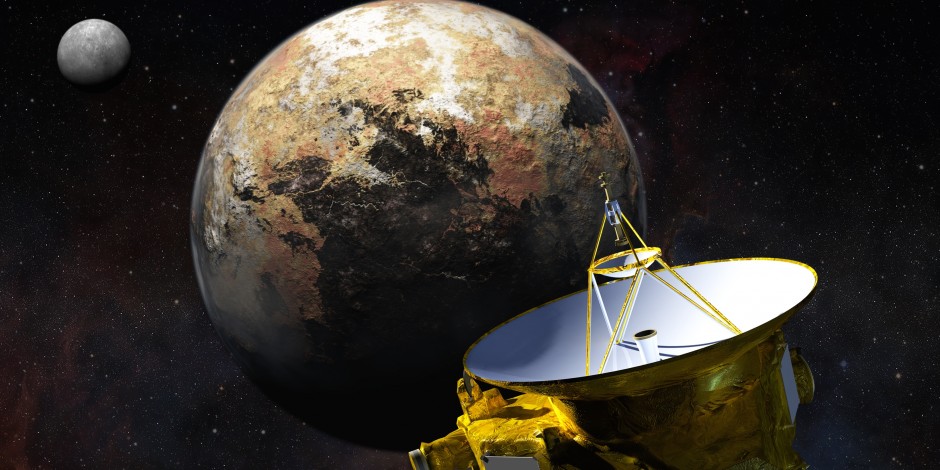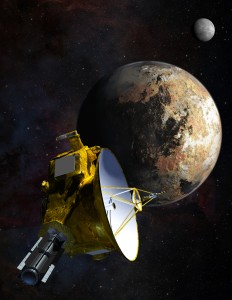Historic encounter

On 14 July 2015 NASA’s New Horizons mission will make the first-ever close flyby of Pluto. The spacecraft should pass the dwarf planet within a distance of 10’000 kilometres at a speed of about 50’000 kilometres per hour.

Artist’s concept of NASA’s New Horizons spacecraft as it passes Pluto and Pluto’s largest moon, Charon, in July 2015.
(Credit: NASA/JHU APL/SwRI/Steve Gribben)
New Horizons should also come as close as 27’000 kilometres to Pluto’s companion Charon.The spacecraft is supposed to take thousands of images and making a wide range of science observations. But since it is about 6 billion kilometres away from Earth it will take approximately 4,5 hours for data to reach us.
The view of the Hubble Space Telescope isn’t sharp enough to see details on the surface of Pluto. But different pictures taken over the years showed by comparison that the distant dwarf planet is not simply a ball of ice and rock but a dynamic world that undergoes atmospheric changes. Therefore astronomers eagerly await the data collected during the historic encounter. One of them is Martin Jutzi, member of PlanetS at the University of Bern. «I am very interested in the mission because the new data should help us to find out how Pluto and it’s moons have been formed,» explains the Swiss scientist. «So far we only know roughly the sizes and densities of these bodies and don’t have much information about their composition and shapes.
Martin Jutzi is a specialist in modelling formation processes in the solar system. In the past he used data collected by another NASA spacecraft called Dawn to reconstruct what happened to a giant asteroid. At the moment Dawn is in orbit around the dwarf planet Ceres, but before, from 2011 to 2012 the spacecraft explored the asteroid Vesta for 14 months. Using a three-dimensional computer model Martin Jutzi was able to show that there was a double impact on Vesta over a billion years ago. The simulations suggest that Vesta with its 500 kilometres diameter owes its elliptical shape to these collisions and that they also scarred its surface structure. «With the data collected by New Horizons we hope to be able to reconstruct the impact event that might have been at the origin of the Pluto-Charon binary system and possibly also generated the debris from which the smaller moons formed» says Martin Jutzi.
The journey to Pluto that costs about 700 million dollars started almost ten years ago when the spacecraft was launched from Cape Canaveral. On its way to the outer solar system it encountered Jupiter and the Jovian moons in 2007. New Horizons is the fastest spacecraft ever launched and will have travelled 4.76 billion kilometres when it reaches its target in mid-July which is almost equal to 32 trips between the Earth and the Sun. After the flyby it is planned that New Horizons will be directed toward one or more Kuiper Belt Objects beyond Pluto. (bva)
http://www.nasa.gov/newhorizons
Categories: External Newsletter
